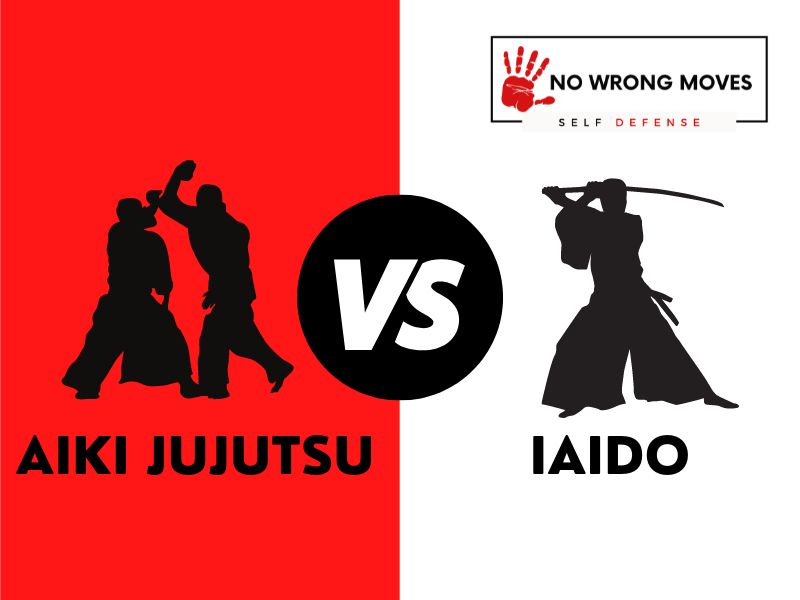
- What We Know About Aiki Jujutsu
- What We Know About Iaido
- Aiki Jujutsu Rankings & Levels
- Iaido Rankings & Levels
- Aiki Jujutsu Vs. Iaido Attire
- What A Typical Aiki Jujutsu Training Session Looks Like
- What A Typical Iaido Training Session Looks Like
- Aiki Jujutsu Movies
- Iaido Movies
- Conclusion: Aiki Jujutsu Vs. Iaido
Today, we are going to end the long-standing debate of Aiki Jujutsu Vs. Iaido! People (especially those online) go back on forth on which discipline is better.
Some say that Aiki Jujutsu is more fluid and instinctive, while others argue that Iaido is more powerful and straightforward. So which is it, and why?
Well...
The main difference between Aiki Jujutsu and Iaido is the focus of each martial art. Aiki Jujutsu emphasizes using an attacker's force and momentum against them, while Iaido focuses on smoothly drawing a sword and striking with precision.
Both can be effective in self-defense situations, but it ultimately depends on the individual's preferences and skill level.
The two disciplines also differ in their history and training methods. Aiki Jujutsu originated as a battlefield combat art, while Iaido developed as a form of swordsmanship for samurai warriors.
Training in Aiki Jujutsu typically involves practicing throws, joint locks, and strikes with the hands and feet, while Iaido training focuses on smooth, precise movements with the
But let's look at these two disciplines in more depth.
Once we've done that, you can decide for yourself...
What We Know About Aiki Jujutsu
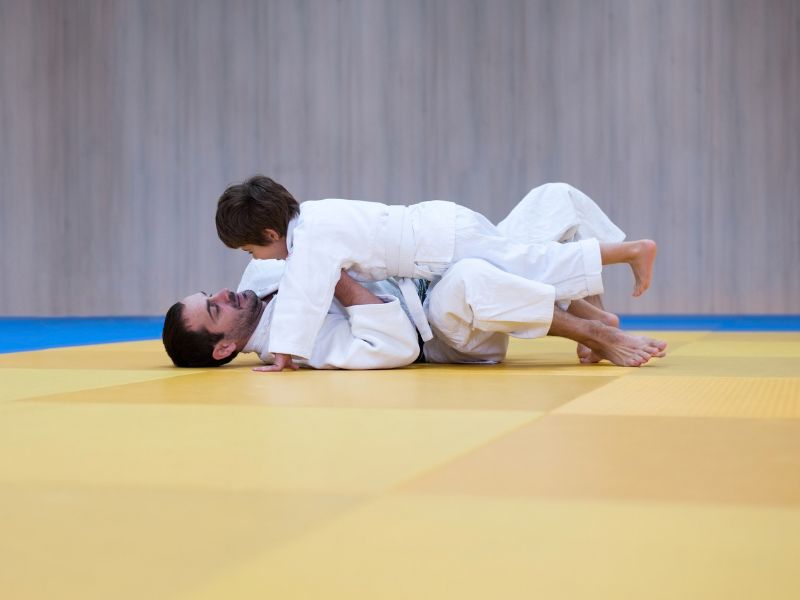
Aiki Jujutsu utilizes harmonizing an opponent's energy with your own internal energy in order to redirect it according to your needs. This is done by blending with the force instead of colliding with it, which would stop it in its tracks.
A practitioner of Aiki Jujutsu uses the striking and evasive techniques of Kempo-Jutsu to position their body close to their opponent before following with linear, diagonal or circular movements to redirect the opponent's energy.
The throwing techniques of Aiki Jujutsu are almost completely dependent upon the Atemi of Kempo-Jutsu. In some cases, with masterful skill, the practitioner can apply Aiki Jujutsu throwing techniques by blending with their opponent's energy.
In most cases, applying an appropriate Aiki Jujutsu throwing technique will disrupt the opponent's balance and send them flying!
The history of Aiki Jujutsu can be traced back to the Shinmei-ryu school of swordsmanship founded by Takenouchi Hisamori in the early 1600s. One of Hisamori's students, Takeda Sokaku, is credited with developing Aiki Jujutsu from the techniques he learned from Hisamori.
Sokaku passed on his knowledge to his son Takeda Tokimune who continued to teach and develop the art until his death in 1943.
Morihei Ueshiba continued to develop the art, creating Aikido, a modernized version of Aiki Jujutsu.
Aiki Jujutsu can still be used for self-defense or as a form of physical and mental exercise. It teaches control over one's own body and mind as well as efficiently using an opponent's energy against them.
What We Know About Iaido

Iaido is a Japanese martial art that emphasizes being aware and capable of quickly drawing the sword and responding to sudden attacks.
The four main components of iaido are the smooth, controlled movements of drawing the sword from its scabbard, striking or cutting an opponent, shaking blood from the blade, and placing the sword in the scabbard.
Iaido can be practiced with a wooden sword (bokken) or a blunt-edged sword called an iaitō. Few, more experienced, iaido practitioners use a sharp-edged sword (shinken). Iaidoka are usually referred to as swordsmen.
The practice of iaido is said to foster inner calm and peace of mind, as well as improve focus, concentration and mental clarity.
On top of all this, regular practice can help to improve physical coordination and balance. While the majority of iaido practitioners are men, there is a growing number of women who are taking up this traditional martial art.
If you are interested in learning iaido, there are several things you need to keep in mind:
- First, find a qualified instructor who can teach you the proper techniques.
- Second, you will need to purchase the proper equipment, which includes a katana (sword), obi (belt), hakama (pleated skirt), zekken (name tag) and menuki (ornament).
- Finally, you will need to commit to practicing on a regular basis in order to improve your skills.
With dedication and perseverance, anyone can learn this fascinating martial art.
Of course, this is only a brief history and understanding of Aiki Jujutsu and Iaido, but if you want to go deeper into either art, be sure to check out the following posts:
Now, back to the comparison...
Let's look at the origins of the respective disciplines and then compare the key elements of their practices. You will be able to understand some of their similarities and differences a bit better afterward.
| Aiki Jujutsu | Iaido | |
| Origins | Japanese | Japanese |
Another thing I think is important to look at is the different rankings and levels in each art. if you are looking to take up either Aiki Jujutsu or Iaido, whether as a hobbyist or to compete, you need to understand the different levels of proficiency and what is required for testing and ranking.
Aiki Jujutsu Rankings & Levels
There are three levels in Aiki Jujutsu: beginner, intermediate, and advanced.
The beginner level is for students who are new to the art and are still learning the basics. At this level, students learn how to defend themselves against basic attacks and how to execute basic moves.
The intermediate level is for students who have mastered the basics and are now learning more advanced techniques. At this level, students learn how to defend themselves against more advanced attacks and how to execute more complex moves.
And last but clearly not least, the advanced level is for students who have mastered the intermediate level and are now learning the most advanced techniques.
At this level, students learn how to defend themselves against the most advanced attacks and how to execute the most complex moves.
Iaido Rankings & Levels
There are four levels or ranks in Iaido: Shoden, Chuden, Okuden, and Masters. Each level has a corresponding system and set of teachings.
Shoden is the first level and is focused on learning the basics of Iaido. Students learn how to perform the five cuts of Iaido, as well as the proper way to hold and draw the sword.
The Shoden system teaches about the philosophy and history of Iaido, as well as how to develop correct posture and breathing habits.
Chuden is the second level and builds on the basic skills learned in Shoden. Students learn more advanced techniques, such as multiple cuts and combinations. The Chuden system also teaches proper footwork and how to use your body to increase power in your strikes.
Okuden is the third level and teaches even more advanced techniques. Students learn how to use their mind and spirit along with their body to achieve maximum effect when striking an opponent. The Okuden system also teaches about meditation and how to control your energy levels.
Master is the highest rank in Iaido and is only achieved after many years of dedicated practice. Masters learn all of the techniques from the previous levels, as well as more advanced forms that are not taught to lower ranking students.
Masters also learn about the spiritual side of Iaido, including how to use ki (energy) for healing purposes.
Aiki Jujutsu Vs. Iaido Attire
This section simply compares the clothing and uniforms that practitioners wear in combat.
Aiki Jujutsu Attire:
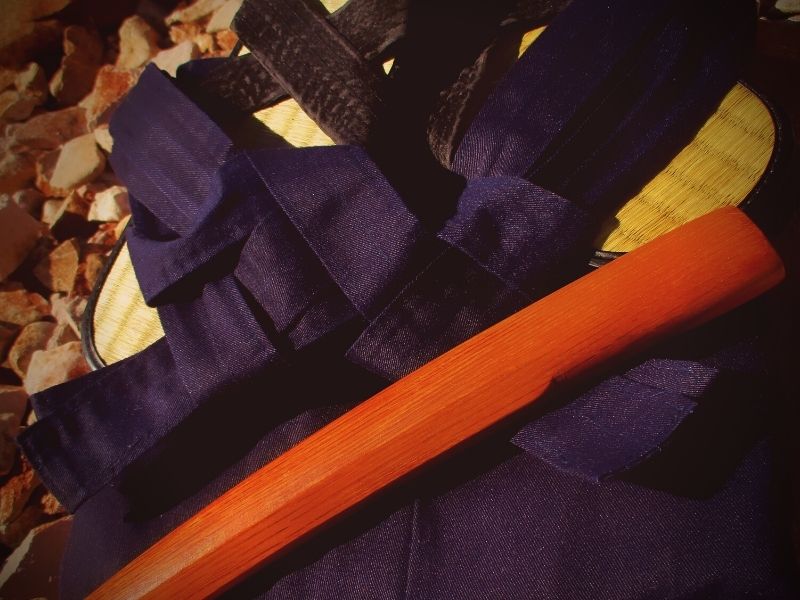
In terms of attire, Aiki Jujutsu practitioners typically wear a traditional dogi and hakama. This allows for better gripping and movement during techniques.
Iaido Attire:
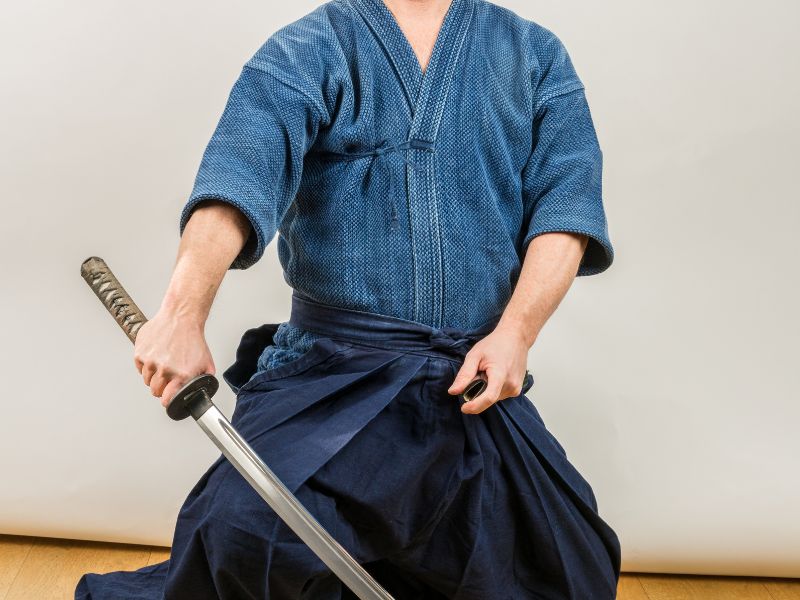
Iaido practitioners traditionally wear a white jacket and black hakama, or pleated skirt.
While some schools have begun to allow students to wear modern clothing, many still insist on the traditional attire. In addition to the clothing, practitioners also typically wear a sword belt (obi) and a cloth headband (hachimaki).
What A Typical Aiki Jujutsu Training Session Looks Like
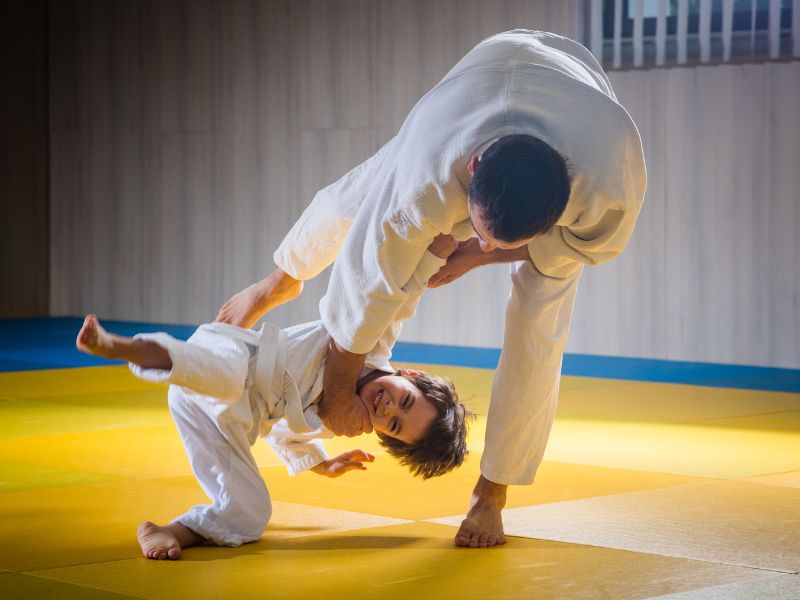
A typical Aiki Jujutsu practice session may start with a few minutes of warm-ups, such as joint rotations and light stretches. This is followed by practicing techniques, which may include throws, locks, and pins. The session usually ends with some relaxation exercises and a cool-down.
One of the most commonly used techniques in Aiki Jujutsu is the wristlock. This involves controlling an opponent's wrist and using their own momentum to throw them off balance.
In addition to physical technique, Aiki Jujutsu also emphasizes mental and spiritual development. This includes cultivating a strong mind-body connection and developing qualities such as patience and awareness.
What A Typical Iaido Training Session Looks Like
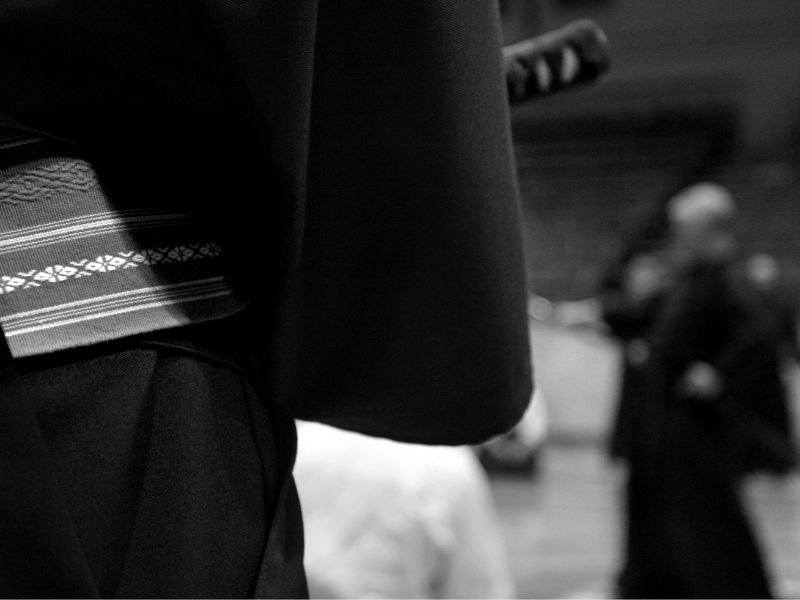
Any Iaido practitioner will tell you that one of the most important aspects of the discipline is proper form. A typical Iaido practice session will therefore involve spending a significant amount of time working on individual techniques, as well as drilling basic movements over and over again.
If the last few sections have been a bit full-on or a bit too technical, you will like this next section! Why? Because who doesn't love a good martial arts flick?
Both Aiki Jujutsu and Iaido have been featured in a number of films and TV shows, so if you want to learn more about them, then entertain yourself with the following 👊
Aiki Jujutsu Movies

These are some of the top movies and shows with Aiki Jujutsu in them:
- The Bourne Identity (2002)
- Kill Bill: Volume 1 (2003)
- The Protector (2005)
- The Matrix Reloaded (2003)
- Ong Bak (2003)
- Daredevil (TV series, 2015-2018)
- The Wolverine (2013)
- Arrow (TV series, 2012-2020)
- John Wick (2014)
- 13 Assassins (2010)
- The Raid (2011)
In The Bourne Identity, the protagonist Jason Bourne (played by Matt Damon) uses Aiki Jujutsu in several fight scenes. He utilizes throws, joint locks, and other techniques to disarm and subdue his opponents.
In The Protector, the main character Kham (played by Tony Jaa) also uses Aiki Jujutsu in his fights. He uses a variety of throws and locks to take down his opponents, often incorporating them into his acrobatic style of fighting.
In The Matrix Reloaded, the character Seraph (played by Collin Chou) uses Aiki Jujutsu in his fight against Neo. He utilizes throws, joint locks, and other techniques to defend himself and attack Neo.
In Ong Bak, the main character Ting (played by Tony Jaa) does not use Aiki Jujutsu specifically, but he does incorporate techniques from Muay Boran, a martial art which shares some similarities with Aiki Jujutsu. Ting uses a variety of strikes, throws, and joint locks to take down his opponents in the film.
In Quentin Tarantino's Kill Bill, you see Aiki Jujutsu techniques used by the protagonist, the Bride (played by Uma Thurman), in her quest for revenge against her former assassin colleagues.
Iaido Movies

And as for movies with Iaido in them, you can look at the following really good ones:
- Kill Bill (2003)
- The Last Samurai (2003)
- Zatoichi (2003)
- 13 Assassins (2010)
- Lone Wolf and Cub: Baby Cart at the River Styx (1972)
- Sword of Doom (1966)
- Sanjuro (1962)
In The Last Samurai, Tom Cruise's character learns the ways of the samurai, including Iaido techniques, from Ken Watanabe's character.
The blind masseur and gambler Zatoichi, played by legendary actor Shintaro Katsu, uses Iaido techniques to defend himself and the helpless in several films about his character.
The 2013 film 13 Assassins features a group of samurai who use Iaido techniques in their mission to assassinate an evil lord.
In the classic chanbara (sword-fighting) film Lone Wolf and Cub: Baby Cart at the River Styx, Tomisaburo Wakayama's character uses Iaido techniques to defeat his enemies.
In Sword of Doom, Tatsuya Nakadai's character is a sociopathic samurai who utilizes Iaido techniques in his ruthless quest for power.
Akira Kurosawa's Sanjuro features Toshiro Mifune as a wandering ronin who uses Iaido techniques to defend himself and those in need.
Conclusion: Aiki Jujutsu Vs. Iaido

I hope you now have a deeper understanding of Aiki Jujutsu and Iaido. In all truth, it is not about which discipline is "better" as they each have their pros and cons. If you do plan on starting classes for either, please check out my other related posts, as I have tried my best to answer all the FAQs related to the art.
Feel free to share this post and any graphics you like, and of course, if you have any questions or thoughts, drop them below or shoot me an email, and I will be happy to assist 🙂
Curious to learn about other great martial arts? Check out BJJ here!
[author-box-jpx-fitness]
